Links to various Aetna Better Health and non-Aetna Better Health sites are provided for your convenience. Aetna Better Health of California is not responsible or liable for non-Aetna Better Health content, accuracy or privacy practices of linked sites or for products or services described on these sites.
How one Philadelphia community came together to fight air pollution and breathe easier
 By Bonnie Vengrow
By Bonnie Vengrow
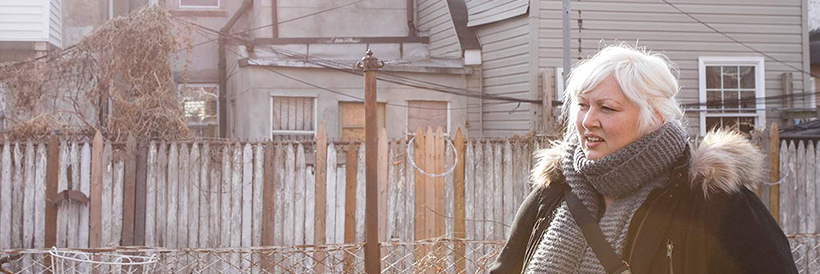
The saws from the scrapyards in Philadelphia’s Kensington neighborhood crackle to life around 9 a.m. Powerful blades slice through mountains of old tires, sending white smoke and ash into the sky ― and into nearby homes, including Genevieve Geer’s. She and her husband, both artists, moved into this diverse area five years ago. They quickly came to dread the stench and grit coming from the scrapyards across the street and down the block. “A burning plastic smell would fill my home,” she remembers. “It was bad on most days, but on hot days, it would be even worse.”
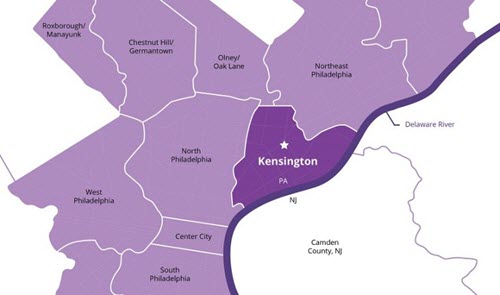
People in this low-income pocket of the city are hardly strangers to polluted air. For most of the last century, Kensington and other River Wards neighborhoods grappled with smog from nearby factories and lead smelters. Today, they try to seal their old row homes against lead-filled dust kicked up by construction crews, exhaust from traffic congestion, and fumes and ash from active scrapyards.

Kensington scrapyards slice old tires, like the ones seen here, for easier shipping overseas.
Years of filing complaints have had little impact. Genevieve spent four years attempting to ban tire cutting in the open air. A law was finally passed last summer, yet the tires still smolder and Genevieve says city inspectors often show up too late to catch scrapyards in the act. So Kensington continues to wipe ash from windowsills, playground equipment and leaves in backyard gardens ― and inhale pollutants that have been linked to serious health issues. One of them, PM2.5, is an ultrafine type of particulate matter commonly found in car emissions. It can penetrate deep into the lungs and cause decreased lung function, more frequent asthma attacks, heart attacks and premature death in people with heart and lung disease.
Air quality ― and its associated health risks ― can vary from area to area. Studies of the blocks around the area’s scrapyards rank as “unhealthy” or “very unhealthy” ― one step above “hazardous” on the Air Quality Index scale. And a recent community health assessment found that children in River Wards have the highest rate of hospitalizations for asthma.
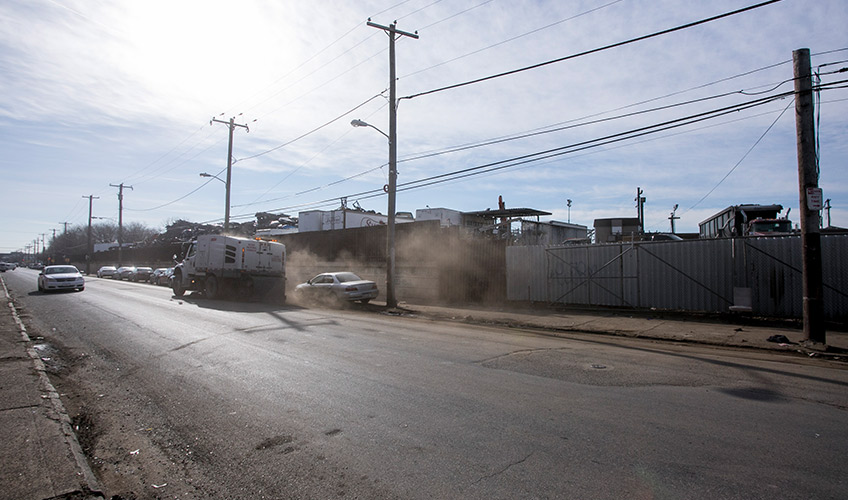
Though cutting tires in the open is now illegal in Philadelphia, some scrapyards still continue the practice.
Helping a community
Kensington may be breathing easier soon, thanks to a new air monitoring program spearheaded by the Clean Air Council (CAC), and funded by a $100,000 Cultivating Healthy Communities grant from the Aetna Foundation. The program’s goals are ambitious but achievable: to educate people about the harmful effects of breathing polluted air, to give them state-of-the-art air monitors and to encourage them to capture important data that can be used to improve the air they breathe.
“We were interested in funding projects that gave neighborhood residents the opportunity to not only understand the environmental hazards in their midst, but also to do something about them,” says Amy Clark, senior program officer at the Aetna Foundation. “The Clean Air Council proposed an approach that literally puts the ability to track air quality in the hands of Kensington residents. They demonstrated Kensington’s need for a project like this, and their plan to meet that need is not only practical, but also places residents at the center of whatever change occurs as a result.”
The Kensington Air Monitoring program officially kicked off in late 2017, but it’s the result of years of surveys, studies and community education efforts. “We knew the scrapyards have been a problem in this neighborhood for a while, and we knew we wanted to use air monitors there,” says Russell Zerbo, advocacy coordinator for the CAC, who oversees the program. “It just so happens that the monitor we’re using now became available and is affordable.”
Because community support was crucial, Russell turned to Genevieve and some of her equally impassioned neighbors. In fact, she was one of the first of a handful in Kensington to use the air monitor. A few days after Russell set it up, Genevieve sent him a screen shot: That morning, the monitor recorded a particulate level of 31 in her backyard. That’s nearly two and a half times higher than the national standard.
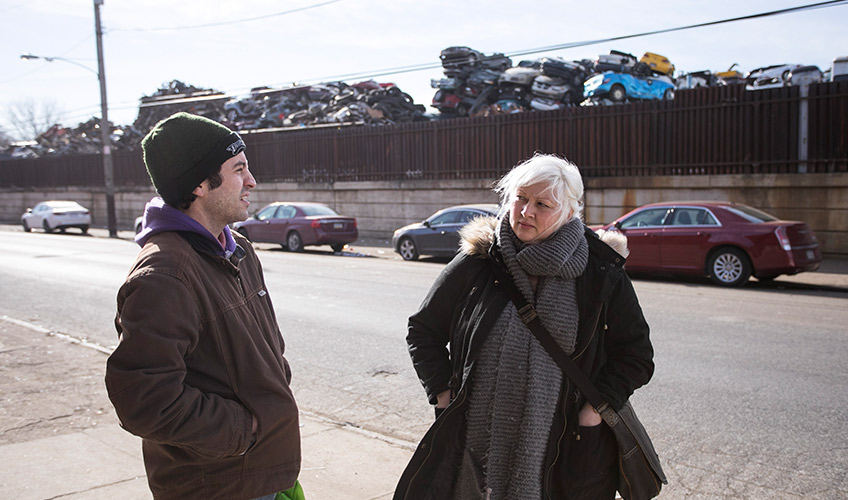
Russell Zerbo and Genevieve Geer, pictured here near one of the four scrapyards surrounding Genevieve’s home.
Tracking the air
It’s not much to look at, the monitor. Just a black, palm-sized plastic square with some lights, a fan and an infrared light. But the data it captures ― and what Kensington and the CAC can do with it ― is nothing short of astonishing. Humidity, temperature, sound and the amount of PM2.5 in the air are all tracked the moment you press the record button on a companion app, which displays real-time results on your smartphone. It also funnels the results, once per second, into a crowdsourced map that displays where PM2.5 concentrations are the highest and lowest in the area. Ideally, a household uses the monitors for two weeks, and then Russell extracts the data and installs it in the next home.
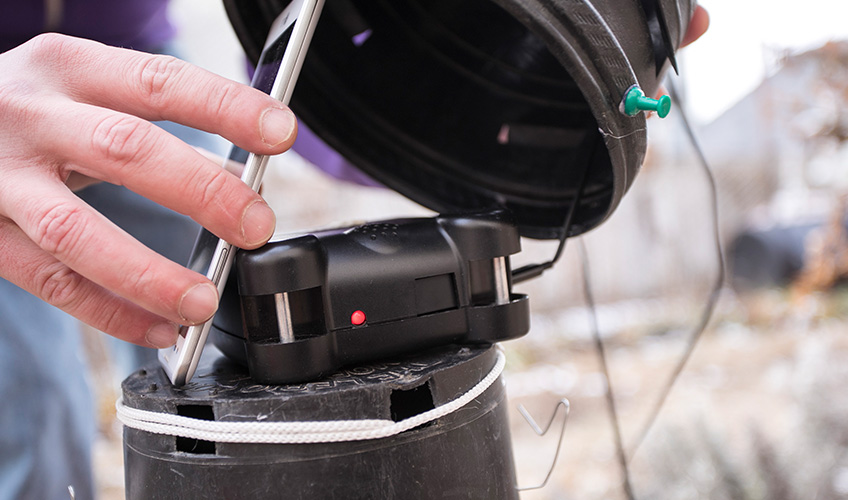
The air monitor, above, can be set up inside or outside the home.
Quality readings often hinge on where the monitor is placed. To determine that, the CAC meets with residents, hears their concerns, and zeroes in on the best place to set up. Monitors can be put inside the home, outside, or worn on a lanyard. “If you’re having trouble breathing at night, let’s place the monitor in the bedroom. If you live close to a scrapyard and have an outdoor outlet, let’s put it out there,” says Karl Koerner, engineering and technical coordinator for the CAC and the one who selected the air monitors. “What’s your concern? Let’s place a monitor there.”
Equally important are on-the-ground observations, he adds. If a resident sees or smells a scrapyard burning tires, for example, they’re asked to make a note of it, either in the app or a notebook. That information can help the CAC identify patterns or determine the reasons behind a spike in air pollution.
Fighting for lasting change
Current plans call for air monitors to rotate among Kensington homes for at least a year. At that point, Karl believes there will be enough information collected to start talking to city council members about making substantive changes, like increased regulation of scrapyards and improved response time to residents’ concerns. “We only need a small amount of data to get the conversation started,” he points out. In the future, air monitoring programs may be implemented in other neighborhoods in the city.
That’s not to say the data can’t be put to good use in the meantime. Besides the crowdsourced heat map, residents are encouraged to use the readings to substantiate their complaints to city officials. After all, it’s hard to dispute numbers.
Data collection is expected to get even more sophisticated in the coming months, when newer monitors with even higher accuracy hit the market. Ultimately, Russell says he’d like to have around 30 at the ready ― which is music to Genevieve’s ears. “These monitors give people power,” she says. “And I think that’s great.”
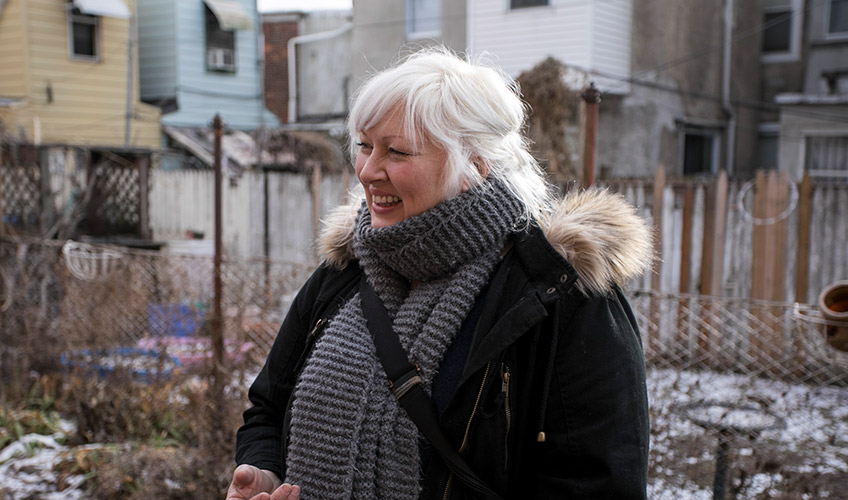
“I love my neighbors and this neighborhood,” Genevieve says.
About the author
Bonnie Vengrow is a journalist based in NYC who has written for Parents, Prevention, Rodale’s Organic Life, Good Housekeeping and others. She’s never met a hiking trail she doesn’t like and is currently working on perfecting her headstand in yoga class.